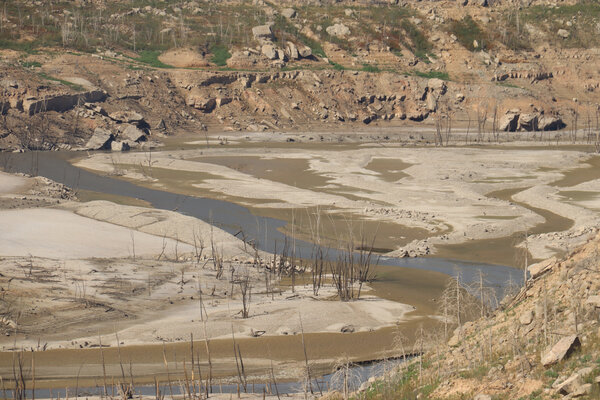Water restrictions tightened further in parts of Catalonia due to ongoing drought
Agricultural, industrial, recreational, and personal use limited in Ter and Llobregat river basins near Catalan capital

The Catalan government has imposed new restrictions on water use in the face of the ongoing and worsening drought.
Restrictions will be placed on agricultural, industrial, and recreational use of water, while personal use will be limited to 230 liters per person per day.
However, climate minister Teresa Jordà explained in a press conference on Tuesday afternoon that 230l is far beyond the average personal use, which is around 117 liters per day.
Water use will have to be reduced by 40% in agriculture and 15% in industry, as a new state of exceptionality is declared around the Ter and Llobregat river basins near the Catalan capital, as well as the Fluvià Muga aquifer. This exceptional state is the fourth stage out of a total of five that form part of Catalonia's drought plan, and Tuesday's announcement sees the areas affected move from the yellow stage to orange.
Jordà explained that the measures are aimed at alleviating the effects of a drought that has now been ongoing for 29 months, a duration that the minister pointed out was 11 months longer than the drought of 2008.
It will also be prohibited to water public and private green areas. Water will be allowed to keep trees alive by a drop system or with sprinklers. Street cleaning with drinkable water will be prohibited.
The Catalan Water Agency expects these measures to come into force by Thursday.
In addition to the water use restrictions, the government has approved a new decree-law intended to protect the networks of sources of drinking water, with the aim of avoiding domestic water supplies being cut.
Authorities also appealed for residents in drought-affected areas where around 6 million people live, including the Catalan capital, to reduce their use of water.
Further actions announced on Tuesday will see extra protection given to reservoirs, an increase of the transfer of water from the Sau reservoir to the nearby Sosqueda one in an attempt to lose none of the water that can be used, as well as a 150% increase in the budget for water transporting vehicles, from €800,000 to €2 million.
Currently, reservoirs are at 28% of their capacity, which is overly "worrying," the Catalan government believes.
During the current spell of drought that Catalonia is undergoing, the famous sunken church at the bottom of the Sau reservoir has become visible in its entirety and a nearby historic cemetery for the first time in many years.
Activation of new water resources
The use of regenerated water has become more and more important in recent months as drought has taken over large parts of Catalonia. In 2022, extraction of water from unconventional and underground sources contributed close to 70 hm3 of public water.
With the introduction of the new exceptional stage of drought, these water extraction methods will be fully activated. In December, with the alert phase activated, tests were already started to provide regenerated water to the final section of the Llobregat river.
The Catalan Water Agency will also request councils that have municipal drought wells to put them into operation. These wells could provide around 300 liters of water per second.
Drought measures protocol
Since October 2021, the emergency plan against drought has been in place. Actions that form part of this plan are determined by a traffic light protocol that Catalan authorities have in place, determining what to do in the event of water levels in reservoirs dipping below a certain threshold. Unlike street traffic lights, this one has five colors: blue, green, yellow, orange, and red.
The traffic light system that Catalonia uses for reservoirs and water use is as follows:
Blue - All normal.
Green - Pre-alert stage, when reservoirs are below 60% full. Authorities monitor water reserves more closely and information campaigns may be published.
Yellow - Alert stage, when reservoirs are below 40% full. The first set of restrictions are brought in, water is distributed in accordance with priority, and the production of non-conventional resources such as aquifers and other underground extractions increases.
Orange - Exceptional state, when reservoir levels are below 25% full. Further reductions in non-priority use of water. Extraction of water from unconventional and underground resources are fully activated. Certain uses are prohibited in urban areas. Allocations reduced for things like agricultural use, recreational use, industrial use. Forbidden to clean streets, sewers, pavements, and buildings with drinking water. A maximum allocation of 230 liters per inhabitant per day is established.
Red - Emergency, when reservoirs are below 16% full. Restrictions in all uses, distribution controlled, but human use is the top priority. A maximum of 200 litres of water per person per day is established, and this can be lowered if necessary.
Podcast
Heavy rain and occasional drought are a common feature of Mediterranean weather, but the picture is looking quite worrying in 2023, with water levels in reservoirs consistently dropping over the past months.
Catalan News published a podcast episode on the ongoing drought situation in September 2022. Have a listen below, or search 'Filling the Sink' wherever you get your podcasts.